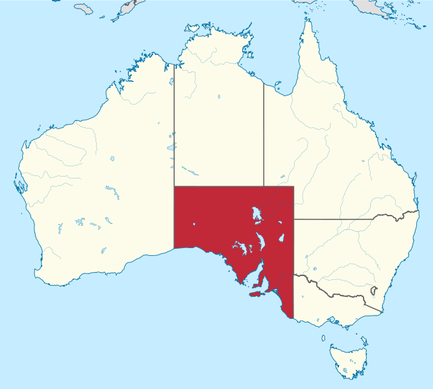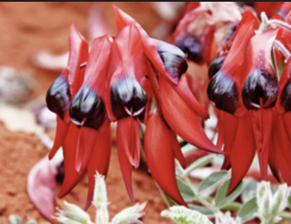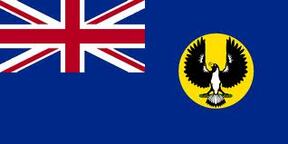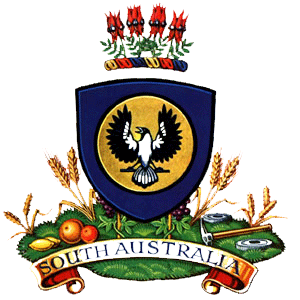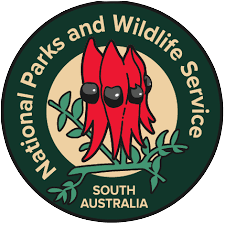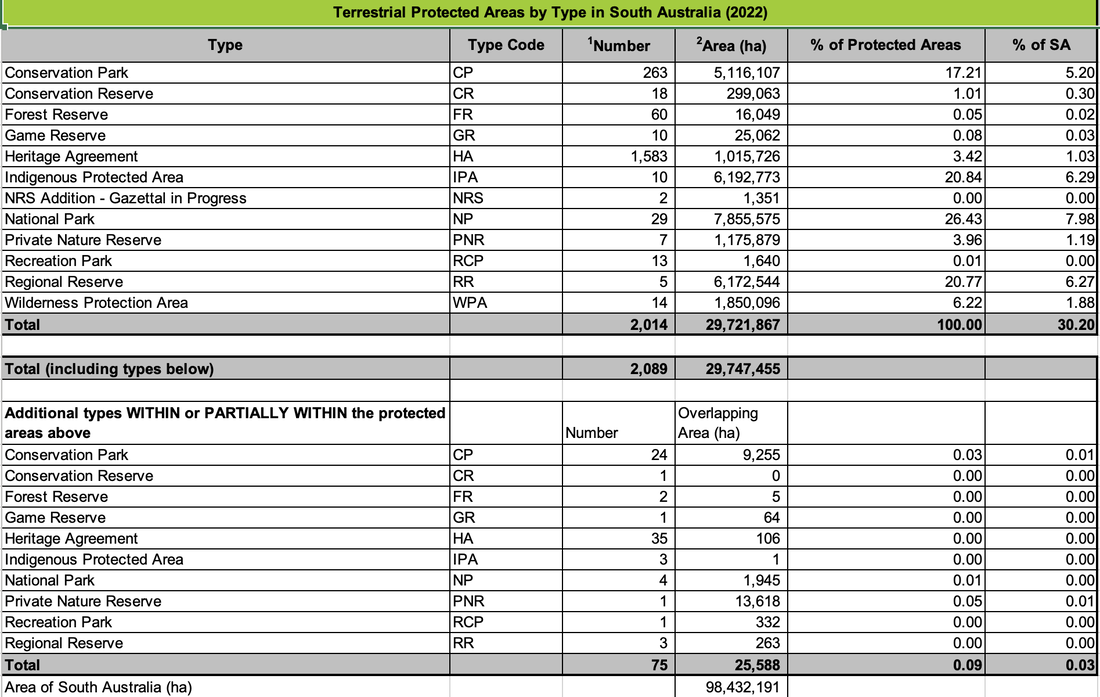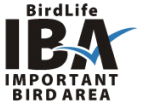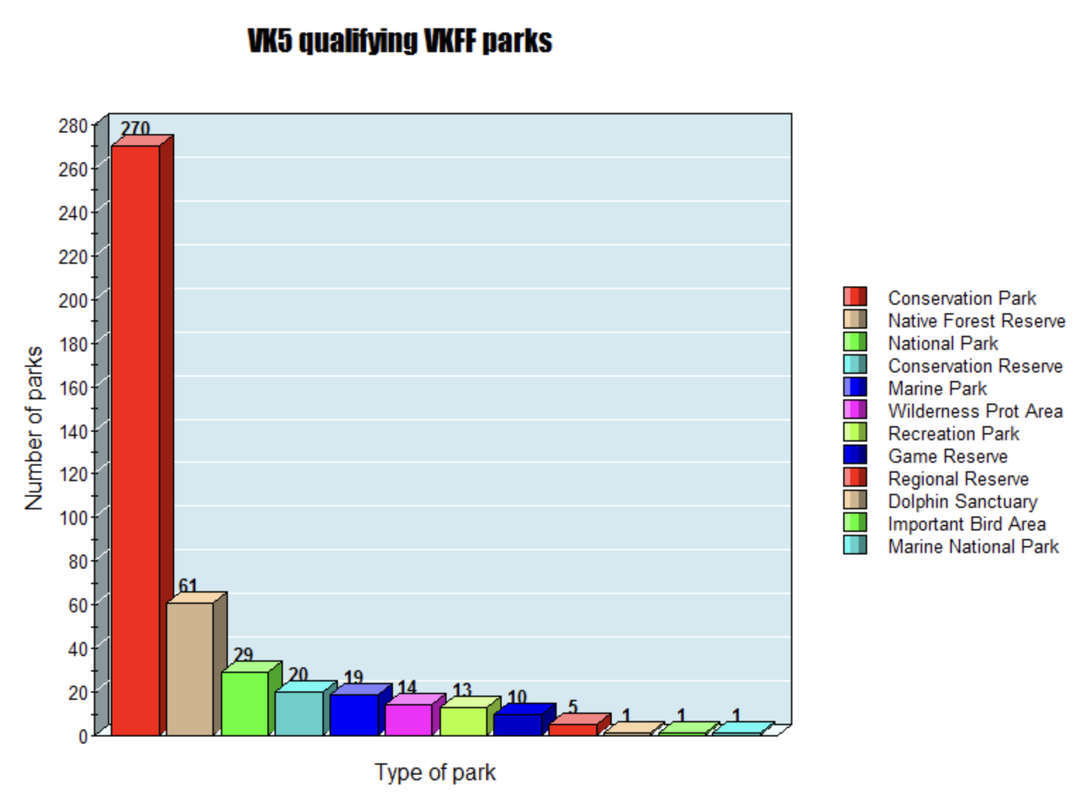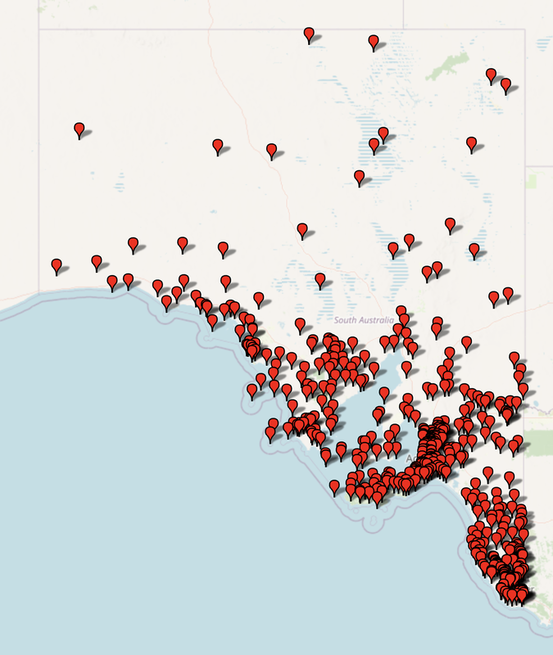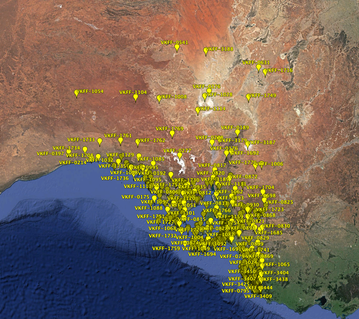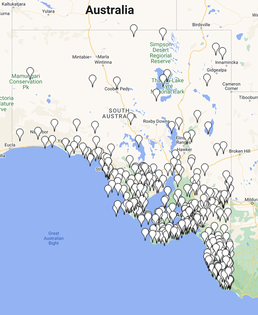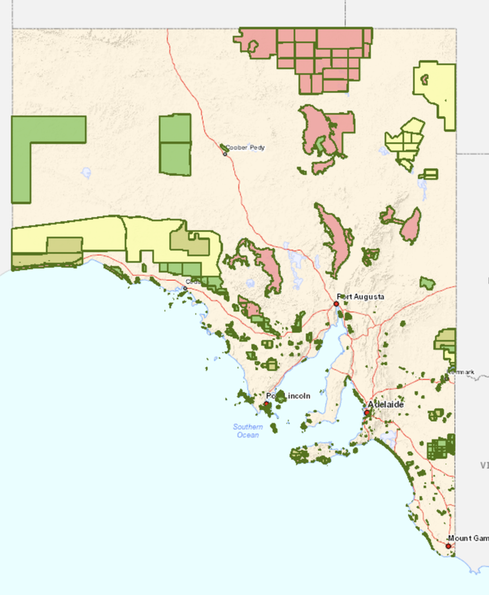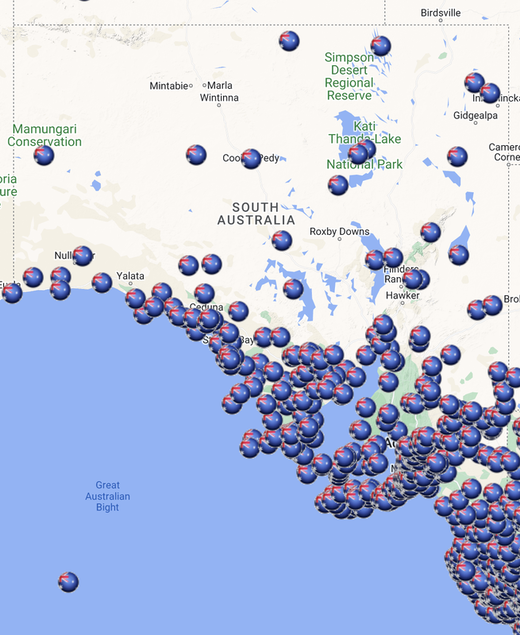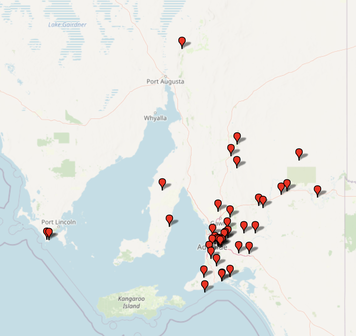SOUTH AUSTRALIA (VK5)
Above:- Image c/o Wikimedia Commons.
South Australia (abbreviated as SA) is a state in the southern central part of Australia. It covers some of the most arid parts of the continent. With a total land area of 983,482 square kilometres (379,725 sq mi), it is the fourth largest of Australia's states and territories.
The capital city is Adelaide.
About 1/5th of the State is conserved in various types of Parks.
The capital city is Adelaide.
About 1/5th of the State is conserved in various types of Parks.
SOUTH AUSTRALIA FAUNA EMBLEM.
|
Above:- Image c/o Eva Hejda http://fotos.naturspot.de/
|
Hairy nose wombat |
SOUTH AUSTRALIA FLORA EMBLEM.
SOUTH AUSTRALIA STATE FLAG.
SOUTH AUSTRALIA COAT OF ARMS.
NATIONAL PARKS AND WILDLIFE SERVICE.
The majority of South Australia's Parks come under the control of the National Parks & Wildlife Service.
More information can be found on their website at..........
TYPES OF PARKS IN SOUTH AUSTRALIA.
South Australia has eight different types of parks.......
Additionally you may see reference to........
- National Parks (NP)
- Areas considered to be of national significance due to wildlife, natural features of the land, or Aboriginal or European heritage.
- Conservation Parks (CP)
- Areas protected for the purpose of conserving wildlife or the natural or historic features of the land.
- Game Reserves (GR)
- Areas set aside for conservation of woildlife and the management of game for seasonal hunting
- Forest Reserve
- Recreation Parks (RP)
- Areas managed for public recreation and enjoyment in a natural setting.
- Regional Reserves (RR)
- Areas proclaims for the purpose of conserving wildlife or natural or historical features while allowing responsible use of the area's natural resources.
- Wilderness Protection Areas (WPA)
- Land set aside under the Wilderness Protection Act 1992 to protect natural and remote areas.
- Conservation Reserves (CR)
- Land set aside for conservation of natural and cultural features under the Crown Land Management Act 2009.
- Marine Parks (MP)
- Areas set aside to preserve the biological diversity of the state's coastal, estuarine and marine environments while allowing ecologically sustainable use of the area's natural resources.
Additionally you may see reference to........
- Indigeneous Protected Areas
- Native Forest Reserves
- Protected zones for Historic Shipwreck sites
- Aquatic Reserves.
- 'Important Bird Areas'
- Important Bird Areas (IBAs) are sites that re recognised as internationally important for bird conservation and known to support key bird species. In a partnership project funded by Rio Tinto, between 2005 and 2009 Birds Australia identified and slected Australia's IBA's. Three hundred and fourteen IBAs have been identified across Australia. There are a total of 38 IBA's in South Australia, covering 7 % of South Australia.
QUALIFYING PARKS IN SOUTH AUSTRALIA.
There are currently 444 parks in South Australia which qualify for WWFF.
They consist of:-
They consist of:-
- 270 x Conservation Parks
- 29 x National Parks
- 20 x Conservation Reserves
- 19 x Marine Parks
- 14 x Wilderness Protection Areas
- 61 x Native Forest Reserves
- 13 x Recreation Parks
- 10 x Game Reserves
- 5 x Regional Reserves
- 1 x Dolphin Sanctuary
- 1 x Important Bird Area
- 1 x Marine National Park
For a full list of qualifying VK5 VKFF parks, please see the Qualifying VK5 parks page.
Above:- Graph showing the types of VKFF parks in South Australia.
Above:- Map showing the location of the VK5 VKFF qualifying parks.
A LIST OF QUALIFYING VK5 PARKS.
- Aberdour Conservation Park VKFF-0994
- Acraman Creek Conservation Park VKFF-0995
- Adelaide Dolphin Sanctuary VKFF-1880
- Adelaide International Bird Sanctuary-Winaityinaityi Pangkara National Park VKFF-1766
- Agery Reserve VKFF-4027
- Aldinga Scrub Conservation Park VKFF-0866
- Althorpe Islands Conservation Park VKFF-0996
- Altona CSR VKFF-4028
- Angove Conservation Park VKFF-0867
- Anstey Hill Recreation Park VKFF-1683
- Avoid Bay Islands Conservation Park VKFF-0997
- Bagdad Native Forest Reserve VKFF-3403
- Baird Bay Islands Conservation Park VKFF-0998
- Bakara Conservation Park VKFF-0868
- Ballaparudda Creek Recreation Park VKFF-3191
- Bandon Conservation Park VKFF-0999
- Bangham Conservation Park VKFF-0869
- Barwell Conservation Park VKFF-1000
- Bascombe Well Conservation Park VKFF-1001
- Baudin Conservation Park VKFF-1002
- Baudin Rocks Conservation Park VKFF-1003
- Beachport Conservation Park VKFF-0791
- Beatrice Islet Conservation Park VKFF-1004
- Belair National Park VKFF-0022
- Belt Hill Conservation Park VKFF-0870
- Bernouilli Conservation Reserve VKFF-1684
- Beyeria Conservation Park VKFF-1005
- Big Heath Conservation Park VKFF-0792
- Billiatt Conservation Park VKFF-0821
- Billiatt Wilderness Protection Area VKFF-1685
- Bimbowrie Conservation Park VKFF-1006
- Bird Islands Conservation Park VKFF-0871
- Black Hill Conservation Park VKFF-0776
- Black Rock Conservation Park VKFF-0872
- Blackwood Forest Recreation Park VKFF-1686
- Bon Bon Station Conservation Reserve VKFF-1769
- Bool Lagoon Game Reserve VKFF-1687
- Boolara Native Forest Reserve VKFF-3404
- Boolcoomatta Conservation Reserve VKFF-1770
- Boondina Conservation Park VKFF-1007
- Brookfield Conservation Park VKFF-0822
- Brownhill Creek Recreation Park VKFF-1688
- Buckaringa Nature Reserve VKFF-4029
- Buckleboo Conservation Reserve VKFF-1689
- Bucks Lake Game Reserve VKFF-1690
- Bullock Hill Conservation Park VKFF-0873
- Bunbury Conservation Reserve VKFF-1691
- Bunkers Conservation Reserve VKFF-1692
- Burra Mine Site Grassland Reserve VKFF-4030
- Burr Slopes Native Forest Reserve VKFF-3405
- Busby Islet Conservation Park VKFF-1009
- Butcher Gap Conservation Park VKFF-0793
- Calectasia Conservation Park VKFF-1010
- Callington Hill Grassland Reserve VKFF-4031
- Calpatanna Waterhole Conservation Park VKFF-1011
- Canunda National Park VKFF-0075
- Cap Island Conservation Park VKFF-1012
- Cape Blanche Conservation Park VKFF-1013
- Cape Bouguer Wilderness Protection Area VKFF-1693
- Cape Gantheaume Conservation Park VKFF-0874
- Cape Gantheaume Wilderness Protection Area VKFF-1694
- Cape Torrens Wilderness Protection Area VKFF-1695
- Cape Willoughby Conservation Park VKFF-1014
- Caralue Bluff Conservation Park VKFF-1015
- Carappee Hill Conservation Park VKFF-1016
- Caratoola Recreation Park VKFF-1696
- Carcuma Conservation Park VKFF-1017
- Caroona Creek Conservation Park VKFF-0875
- Carpenter Rocks Conservation Park VKFF-1018
- Carribie Conservation Park VKFF-0876
- Cave Range Native Forest Reserve VKFF-3406
- Chadinga Conservation Park VKFF-1019
- Charleston Conservation Park VKFF-0777
- Chowilla Game Reserve VKFF-1697
- Chowilla Regional Reserve VKFF-1698
- Christmas Hill Native Forest Reserve VKFF-2893
- Christmas Rocks Conservation Park VKFF-1020
- Cleland National Park VKFF-3185
- Clements Gap Conservation Park VKFF-0812
- Clinton Conservation Park VKFF-0813
- Cobbler Creek Recreation Park VKFF-1699
- Cocata Conservation Park VKFF-1021
- Coffin Bay National Park VKFF-0105
- Comaum Native Forest Reserve VKFF-3407
- Congeratinga Native Forest Reserve VKFF-2896
- Cooltong Conservation Park VKFF-0823
- Coorong National Park VKFF-0115
- Coralinga Native Forest Reserve VKFF-2890
- Corrobinnie Hill Conservation Park VKFF-1022
- Cortlinye Conservation Reserve VKFF-1700
- Cox Scrub Conservation Park VKFF-0824
- Cox Scrub Conservation Reserve VKFF-1701
- Cromer Conservation Park VKFF-0779
- Cudlee Creek Conservation Park VKFF-1023
- Cudlee Creek Native Forest Reserve VKFF-2889
- Cunyarie Conservation Reserve VKFF-1702
- Currency Creek Game Reserve VKFF-1703
- Custon Conservation Park VKFF-1024
- Cygnet Estuary Conservation Park VKFF-1130
- Danggali Conservation Park VKFF-0825
- Danggali Wilderness Protection Area VKFF-1704
- Darke Range Conservation Park VKFF-0806
- DB Mack Reserve VKFF-4032
- Deadmans Swamp Native Forest Reserve VKFF-3408
- Deep Creek National Park VKFF-3186
- Desert Camp Conservation Park VKFF-0794
- Desert Camp Conservation Reserve VKFF-1705
- Dhilba Guuranda-Innes National Park VKFF-0243
- Dingley Dell Conservation Park VKFF-1025
- Doris Coulls Reserve VKFF-4033
- Doris Odgers Reserve VKFF-4065 (open by appointment only)
- Douglas Point Conservation Park VKFF-0795
- Dry Creek Native Forest Reserve VKFF-3409
- Dudley Conservation Park VKFF-0809
- Eastern Spencer Gulf Marine Park VKFF-1706
- Eba Island Conservation Park VKFF-1026
- Elliott Price Conservation Park VKFF-1028
- Encounter Marine Park VKFF-1707
- Engelbrook Reserve VKFF-4034
- Eric Bonython Conservation Park VKFF-0877
- Ettrick Conservation Park VKFF-1029
- Ewens Ponds Conservation Park VKFF-0796
- Fairview Conservation Park VKFF-0879
- Far West Coast Marine Park VKFF-1708
- Ferguson Conservation Park VKFF-0880
- Ferries McDonald Conservation Park VKFF-0881
- Finnis Conservation Park VKFF-1030
- Flinders Chase National Park VKFF-0173
- Flinders Island 'Important Bird Area VKFF-0175
- Folland Park Reserve VKFF-4035
- Fort Glanville Conservation Park VKFF-1031
- Fowlers Bay Conservation Park VKFF-1032
- Franklin Harbor Conservation Park VKFF-0807
- Franklin Harbor Marine Park VKFF-1709
- Fraser Reserve VKFF-4066 (visit only by contacting Natural heritage Manager)
- Furner Conservation Park VKFF-0882
- Gambier Islands Conservation Park VKFF-1033
- Gambier Islands Group Marine Park VKFF-1710
- Gawler Ranges Conservation Park VKFF-3812
- Gawler Ranges National Park VKFF-0192
- Geegeela Conservation Park VKFF-0883
- Giles Conservation Park VKFF-0884
- Gillap North Native Forest Reserve VKFF-3410
- Gillap South Native Forest Reserve VKFF-3411
- Glen Roy Conservation Park VKFF-0797
- Glencoe Hill Native Forest Reserve VKFF-3412
- Glenthorne - Ityamaiitpina Yarta National Park VKFF-3027
- Gluepot Reserve VKFF-4036
- Goose Island Conservation Park VKFF-1034
- Gower Conservation Park VKFF-0798
- Granite Island Recreation Park VKFF-1711
- Grass Tree Conservation Park VKFF-0885
- Great Australian Bight Marine National Park VKFF-0214
- Greenhill Recreation Park VKFF-1712
- Greenly Island Conservation Park VKFF-1035
- Grundy Lane Native Forest Reserve VKFF-3413
- Guichen Bay Conservation Park VKFF-1036
- Gum Lagoon Conservation Park VKFF-0886
- Gum Tree Gully Conservation Park VKFF-0887
- Hacket Hill Native Forest Reserve VKFF-3414
- Hacks Lagoon Conservation Park VKFF-0888
- Hale Conservation Park VKFF-0889
- Hallet Cove Conservation Park VKFF-0890
- Hambidge Wilderness Protection Area VKFF-1713
- Hanson Scrub Conservation Park VKFF-0891
- Hardings Springs Conservation Reserve VKFF-1714
- Heggarton Conservation Park VKFF-1037
- Hells Hole Native Forest Reserve VKFF-3415
- Hesperilla Conservation Park VKFF-1038
- Hincks Conservation Park VKFF-1039
- Hincks Wilderness Protection Area VKFF-1715
- Hindmarsh Valley National Park VKFF-3190
- HK Fry Reserve VKFF-4037
- Hogwash Bend Conservation Park VKFF-0892
- Honan Native Forest Reserve VKFF-3416
- Honeysuckle Native Forest Reserve VKFF-3417
- Hopkins Creek Conservation Park VKFF-0893
- Horsnell Gully Conservation Park VKFF-0894
- Ikara-Flinders Rangers National Park VKFF-0176
- Innamincka Regional Reserve VKFF-1716
- Investigator Marine Park VKFF-1717
- Investigator Group Wilderness Protection Area VKFF-1718
- Ironstone Hill Conservation Park VKFF-0895
- Island Swamp Native Forest Reserve VKFF-3418
- Jip Jip Conservation Park VKFF-0896
- Kaiserstuhl Conservation Park VKFF-0897
- Kalumunda Native Forest Reserve VKFF-2894
- Kangaroo Flat Native Forest Reserve VKFF-3419
- Kanku-Breakaways Conservation Park VKFF-1008
- Kapunda Island Conservation Park VKFF-1040
- Karte Conservation Park VKFF-0898
- Kathai Conservation Park VKFF-1041
- Kati Thanda- Lake Eyre National Park VKFF-0276
- Kay Native Forest Reserve VKFF-3420
- Kellidie Bay Conservation Park VKFF-1042
- Kelly Hill Conservation Park VKFF-0810
- Kelvin Powrie Conservation Park VKFF-0899
- Kenneth Stirling Conservation Park VKFF-0781
- Kennion Native Forest Reserve VKFF-3421
- Kersbrook Native Forest Reserve VKFF-2887
- Kinchina Conservation Park VKFF-1764
- King Tree Native Forest Reserve VKFF-3422
- Knott Hill Native Forest Reserve VKFF-2892
- Konetta Native Forest Reserve VKFF-3423
- Kulliparu Conservation Park VKFF-1043
- Kungari Conservation Park VKFF-1044
- Kyeema Conservation Park VKFF-0826
- Lacroma Conservation Reserve VKFF-1719
- Lake Frome Conservation Park VKFF-0900
- Lake Frome National Park VKFF-3187
- Lake Gairdner National Park VKFF-0277
- Lake Gilles Conservation Park VKFF-0901
- Lake Hawdon South Conservation Park VKFF-1045
- Lake Newland Conservation Park VKFF-1046
- Lake Robe Game Reserve VKFF-1721
- Lake Short Conservation Reserve VKFF-4038
- Lake St Clair Conservation Park VKFF-1047
- Lake Torrens National Park VKFF-0278
- Lashmar Conservation Park VKFF-0902
- Laslett Native Forest Reserve VKFF-3424
- Lathami Conservation Park VKFF-0903
- Laura Bay Conservation Park VKFF-1048
- Lawari Conservation Park VKFF-1767
- Lenger Reserve VKFF-4039
- Lenswood Centennial Park VKFF-4040
- Lesueur Conservation Park VKFF-1049
- Leven Beach Conservation Park VKFF-0814
- Lincoln Conservation Park VKFF-1050
- Lincoln National Park VKFF-0286
- Lipson Island Conservation Park VKFF-1051
- Little Dip Conservation Park VKFF-0904
- Little Mount Crawford Native Forest Reserve VKFF-2884
- Lobethal Bushland Park VKFF-4041
- Loch Luna Game Reserve VKFF-1723
- Long Island Recreation Park VKFF-1724
- Long Native Forest Reserve VKFF-3425
- Loveday Reserve VKFF-4042
- Lowan Conservation Park VKFF-1052
- Lower Glenelg River Conservation Park VKFF-0905
- Lower South East Marine Park VKFF-1725
- Lower Yorke Peninsula Marine Park VKFF-1726
- Maize Island Conservation Park VKFF-0827
- Malgra Conservation Park VKFF-1053
- Malcolm Wicks Reserve VKFF-4043
- Malkumba-Coongie Lakes National Park VKFF-0631
- Malone Heath Native Forest Reserve VKFF-3426
- Mamungari Conservation Park VKFF-1054
- Manning Flora & Fauna Reserve VKFF-4044
- Mantung Conservation Park VKFF-1055
- Marino Conservation Park VKFF-1056
- Mark Oliphant Conservation Park VKFF-0782
- Marne Valley Conservation Park VKFF-0906
- Martin Washpool Conservation Park VKFF-0907
- Martindale Hall Conservation Park VKFF-1057
- Mary Seymour Conservation Park VKFF-0908
- McRosties Native Forest Reserve VKFF-3427
- Media Island Conservation Park VKFF-1058
- Memory Cove Wilderness Protection Area VKFF-1727
- Messent Conservation Park VKFF-0799
- Middlecamp Hills Conservation Park VKFF-1059
- Mimbara Conservation Park VKFF-1060
- Minlacowie Conservation Park VKFF-0909
- Moana Sands Conservation Park VKFF-1061
- Mokota Conservation Park VKFF-1062
- Monarto Conservation Park VKFF-0828
- Monarto Woodlands Conservation Park VKFF-1763
- Montacute Conservation Park VKFF-0910
- Moody Tank Conservation Park VKFF-1063
- Moongi Conservation Reserve VKFF-1728
- Moorook Game Reserve VKFF-1729
- Moorunde Wildlife Reserve VKFF-4045
- Mootra Conservation Reserve VKFF-1730
- Morgan Conservation Park VKFF-0911
- Morialta Conservation Park VKFF-0783
- Mount Benson Native Forest Reserve VKFF-3428
- Mount Billy Conservation Park VKFF-0912
- Mount Boothby Conservation Park VKFF-0913
- Mount Brown Conservation Park VKFF-0914
- Mount Dutton Bay Conservation Park VKFF-0915
- Mount Gawler Native Forest Reserve VKFF-2888
- Mount George Conservation Park VKFF-0784
- Mount Magnificent Conservation Park VKFF-0916
- Mount McIntyre Native Forest Reserve VKFF-3429
- Mount Monster Conservation Park VKFF-0800
- Mount Panorama Native Forest Reserve VKFF-2891
- Mount Remarkable National Park VKFF-0360
- Mount Scott Conservation Park VKFF-0918
- Mount Taylor Conservation Park VKFF-1064
- Mount Watch Native Forest Reserve VKFF-3430
- Mowantjie Willauwar Conservation Park VKFF-0919
- Mud Islands Game Reserve VKFF-1731
- Muddy Flat Native Forest Reserve VKFF-3431
- Mulbura Park Reserve VKFF-4046
- Mullinger Swamp Conservation Park VKFF-1065
- Munga-Thirri Simpson Desert National Park VKFF-3188
- Muntiri Reserve VKFF-4047
- Munyaroo Conservation Park VKFF-0920
- Murray Park Reserve VKFF-4048
- Murray River National Park VKFF-0372
- Murrunatta Conservation Park VKFF-1066
- Mutton Cove Conservation Reserve VKFF-2246
- Mylor Conservation Park VKFF-0785
- Myponga Conservation Park VKFF-0921
- Nangwarry Native Forest Reserve VKFF-3432
- Naracoorte Caves National Park VKFF-0380
- Native Wells Native Forest Reserve VKFF-3433
- Nene Valley Conservation Park VKFF-0801
- Nepean Bay Conservation Park VKFF-1067
- Neptune Islands Conservation Park VKFF-1068
- Neptune Islands Group Marine Park VKFF-1732
- Newland Head Conservation Park VKFF-0922
- Ngarkat Conservation Park VKFF-0829
- Ngaut Ngaut Conservation Park VKFF-1069 (currently not accessible to amateurs)
- Nicolas Baudin Island Conservation Park VKFF-1070
- Nilpena Ediacara National Park VKFF-3179
- Nixon Skinner Conservation Park VKFF-0923
- Nullarbor National Park VKFF-0397
- Nullarbor Regional Reserve VKFF-1733
- Nullarbor Wilderness Protection Area VKFF-1734
- Nurragi Conservation Reserve VKFF-2247
- Nurrutti Reserve VKFF-4049
- Nuyts Archipelago Conservation Park VKFF-1071
- Nuyts Archipelago Marine Park VKFF-1735
- Nuyts Archipelago Wilderness Protection Area VKFF-1736
- Nuyts Reef Conservation Park VKFF-1072
- Olive Island Conservation Park VKFF-1073
- Onkaparinga River National Park VKFF-0402
- Onkaparinga River Recreation Park VKFF-1738
- Overland Track Native Forest Reserve VKFF-3434
- Padthaway Conservation Park VKFF-0924
- Pandappa Conservation Park VKFF-1131
- Para Wirra Conservation Park VKFF-1739
- Paranki Lagoon Conservation Park VKFF-1074
- Parndana Conservation Park VKFF-0925
- Peachna Conservation Park VKFF-1075
- Peebinga Conservation Park VKFF-0830
- Pelican Lagoon Conservation Park VKFF-0926
- Penambol Conservation Park VKFF-0802
- Pengilly Scrub (Mudla Wirra Reserve) VKFF-4050
- Penguin Island Conservation Park VKFF-1076
- Penola Conservation Park VKFF-0803
- Piccaninnie Ponds Conservation Park VKFF-0927
- Pigface Island Conservation Park VKFF-1077
- Pike River Conservation Park VKFF-0831
- Pimpala Conservation Reserve VKFF-4051
- Pine Hill Soak Conservation Park VKFF-1078
- Pinkawillinie Conservation Park VKFF-1079
- Pinkawillinie Reservoir Conservation Reserve VKFF-1740
- Point Bell Conservation Park VKFF-1080
- Point Davenport Conservation Park VKFF-0928
- Point Labatt Conservation Park VKFF-1081
- Pond Flat Native Forest Reserve VKFF-3435
- Poocher Swamp Game Reserve VKFF-1741
- Pooginook Conservation Park VKFF-0929
- Poolgarra Conservation Reserve VKFF-1742
- Poonthie Ruwe Conservation Park VKFF-1082
- Porter Scrub Conservation Park VKFF-0787
- Pualco Range Conservation Park VKFF-1083
- Pullen Island Conservation Park VKFF-1084
- Pureba Conservation Park VKFF-1085
- Ramco Point Conservation Park VKFF-0930
- Ramsay Conservation Park VKFF-0815
- Ravine des Casoars Wilderness Protection Area VKFF-1743
- Red Banks Conservation Park VKFF-1086
- Reedy Creek Conservation Park VKFF-0931
- Ridley Conservation Park VKFF-0932
- Rilli Island Conservation Park VKFF-1087
- Roachdale Reserve VKFF-4052
- Rock Shelter Native Forest Reserve VKFF-34436
- Rocky Island (North) Conservation Park VKFF-1088
- Rocky Island (South) Conservation Park VKFF-1089
- Rocky Reserve Native Forest Reserve VKFF-3437
- Roonka Conservation Park VKFF-1090
- Round Waterhole Native Forest Reserve VKFF-3438
- Rudall Conservation Park VKFF-1091
- Salt Lagoon Islands Conservation Park VKFF-1092 (private property - access approval required)
- Sandy Creek Conservation Park VKFF-0933
- Sceale Bay Conservation Park VKFF-1093
- Scott Conservation Park VKFF-0934
- Scott Creek Conservation Park VKFF-0788
- Seal Bay Conservation Park VKFF-1094
- Searcy Bay Conservation Park VKFF-1095
- Seddon Conservation Park VKFF-1096
- Shannon Conservation Park VKFF-1097
- Sheoak Hill Conservation Park VKFF-0935
- Shepherds Hill Recreation Park VKFF-1744
- Simpson Conservation Park VKFF-1098
- Sinclair Island Conservation Park VKFF-1100
- Sir Joseph Banks Group Conservation Park VKFF-1101
- Sir Joseph Banks Group Marine Park VKFF-1746
- Sleaford Mere Conservation Park VKFF-1102
- Snow Gum Native Forest Reserve VKFF-3439
- Southern Kangaroo Island Marine Park VKFF-1747
- Southern Spencer Gulf Marine Park VKFF-1748
- Spring Gully Conservation Park VKFF-0816
- Spring Mount Conservation Park VKFF-0789
- Springs Road Native Forest Reserve VKFF-2895
- Stipiturus Conservation Park VKFF-0936
- Strzelecki Regional Reserve VKFF-1749
- Sturt Gorge Recreation Park VKFF-1750
- Swan Reach Conservation Park VKFF-0832
- Talapar Conservation Park VKFF-1103
- Talisker Conservation Park VKFF-0790
- Tallaringa Conservation Park VKFF-1104
- Tantanoola Caves Conservation Park VKFF-0804
- Telford Scrub Conservation Park VKFF-0805
- Tennyson Dunes Conservation Reserve VKFF-2248
- The Bluff Native Forest Reserve VKFF-3440
- The Dutchmans Stern Conservation Park VKFF-0817
- The Heath Native Forest Reserve VKFF-3441
- The Knoll Conservation Park VKFF-0937
- The Marshes Native Forest Reserve VKFF-3442
- The Pages Conservation Park VKFF-1106
- The Plug Range Conservation Park VKFF-1107
- The Woolwash Native Forest Reserve VKFF-3443
- Thidna Conservation Park VKFF-2250
- Thorny Passage Marine Park VKFF-1751
- Tilley Swamp Conservation Park VKFF-0938
- Tola Conservation Reserve VKFF-1753
- Tolderol Game Reserve VKFF-1752
- Topperwein Native Forest Reserve VKFF-3444
- Torrens Island Conservation Park VKFF-0939
- Totness Recreation Park VKFF-1754
- Tower Hill Native Forest Reserve VKFF-2885
- Troubridge Island Conservation Park VKFF-1108
- Tucknott Scrub Conservation Park VKFF-1109
- Tumby Bay Conservation Park VKFF-1110
- Unnamed (No. HA95) VKFF-4053
- Unnamed (No. HA148) VKFF-4054
- Unnamed (No. HA1264) VKFF-4055
- Unnamed (No. HA1362) VKFF-4056
- Unnamed (No. HA1446) VKFF-4057
- Unnamed (No. HA1520) VKFF-4058
- Unnamed (No. HA1618) VKFF-4059
- Upper Gulf St Vincent Marine Park VKFF-1755
- Upper South East Marine Park VKFF-1756
- Upper Spencer Gulf Marine Park VKFF-1757
- Venus Bay Conservation Park VKFF-1111
- Verran Tanks Conservation Park VKFF-1112
- Vivigani Ardune Conservation Park VKFF-1113
- Vivonne Bay Conservation Park VKFF-0811
- Vulkathunha-Gammon Ranges National Park VKFF-0189
- Wabma Kadarbu Mound Springs Conservation Park VKFF-1114
- Wahgunhyah Conservation Park VKFF-1115
- Waite Conservation Reserve VKFF-4060
- Waitparinga Reserve VKFF-4061
- Waitpinga Conservation Park VKFF-0940
- Waldegrave Islands Conservation Park VKFF-1116
- Walter Newell Reserve VKFF-4062
- Wandilo Native Forest Reserve VKFF-3445
- Wanilla Conservation Park VKFF-1117
- Wanilla Land Settlement Conservation Park VKFF-1118
- Wapma Thura - Southern Flinders Ranges National Park VKFF-3189
- Warreanga Native Forest Reserve VKFF-3446
- Warren Conservation Park VKFF-0941
- Warrenben Conservation Park VKFF-0818
- Watts Gully Native Forest Reserve VKFF-2886
- West Coast Bays Marine Park VKFF-1758
- West Island Conservation Park VKFF-1119
- Western Kangaroo Island Marine Park VKFF-1759
- Western River Wilderness Protection Area VKFF-1760
- Whalers Way Sanctuary VKFF-4063
- Wharminda Conservation Park VKFF-1120
- Whennen Native Forest Reserve VKFF-3447
- Whidbey Isles Conservation Park VKFF-1121
- White Dam Conservation Park VKFF-1122
- White Waterhole Native Forest Reserve VKFF-3448
- Whyalla Conservation Park VKFF-0808
- Wiljani Conservation Park VKFF-1159
- Wills Creek Conservation Park VKFF-0819
- Windy Hill Native Forest Reserve VKFF-3449
- Winninowie Conservation Park VKFF-0820
- Witjira National Park VKFF-0541
- Wittelbee Conservation Park VKFF-1123
- Woakwine Conservation Park VKFF-1124
- Wolseley Common Conservation Park VKFF-1125
- Wombat Flat Native Forest Reserve VKFF-3450
- Woorabinda Bushland Reserve VKFF-4064
- Yalpara Conservation Park VKFF-1126
- Yeldulknie Conservation Park VKFF-1127
- Yellabinna Regional Reserve VKFF-1761
- Yellabinna Wilderness Protection Area VKFF-1762
- Yulte Conservation Park VKFF-1128
- Yumbara Conservation Park VKFF-1129
WHICH PARKS DO NOT QUALIFY FOR VKFF IN VK5?
The VKFF Team are currently undertaking enquiries with private organisations who own Heritage Agreements.
There are also seven (7) Private Nature Reserves which will soon be added to the WWFF Directory.
There are also seven (7) Private Nature Reserves which will soon be added to the WWFF Directory.
HOW TO FIND WHERE THE QUALIFYING PARKS ARE IN SOUTH AUSTRALIA?
You can use the KML file below to upload to either Google Earth or My Google Maps, to show you the location of the VK5 VKFF qualifying parks (current as of 28th June 2023).
Please note that the latitude and longitude are a guide only. Please notify the VKFF National Co-Ordinator should you find an error with the latitude and longitude of a park. Send an email to [email protected]
Please note that the latitude and longitude are a guide only. Please notify the VKFF National Co-Ordinator should you find an error with the latitude and longitude of a park. Send an email to [email protected]
Right click on the file and save it to your desktop and then open the file.
| vk5_vkff_parks.kml | |
| File Size: | 138 kb |
| File Type: | kml |
Google Earth - parks shapefile.
You can download the CAPAD 2022 parks shapefile via the link below.....
www.environment.gov.au/fed/catalog/search/resource/details.page?uuid=%7B4448CACD-9DA8-43D1-A48F-48149FD5FCFD%7D
Be aware that the .shp file is very large.
By importing the .shp file into Google Earth, you will be able to view all protected areas in Australia.
www.environment.gov.au/fed/catalog/search/resource/details.page?uuid=%7B4448CACD-9DA8-43D1-A48F-48149FD5FCFD%7D
Be aware that the .shp file is very large.
By importing the .shp file into Google Earth, you will be able to view all protected areas in Australia.
Location SA Map Viewer.
Location SA Map Viewer is an excellent resource to find the location and boundary of South Australian parks.
Click on 'Datasets' and then click on 'Environment & Climate" and in turn click on 'Environment'.
This will bring you to a number of options. Click on either 'NPW and Conservation Properties' or 'NPW and Conservation Reserve Boundaries'.
This will bring you to a number of options. Click on either 'NPW and Conservation Properties' or 'NPW and Conservation Reserve Boundaries'.
OpenStreetMap.
GMA Map.
WWFF is working very hard to complete and update the map. Alena OK2APY is the WWFF Map Manager. If you have remarks, adds or whatever please drop her a mail : [email protected]
Above:- South Australia (VK5) on the GMA Mapping site.
EXTRA INFORMATION.
WWFF HISTORY IN SOUTH AUSTRALIA.
4th July 2023:
Forty (40) new parks were added to the WWFF Directory. Agery Reserve VKFF-4027 - Fraser Reserve VKFF-4066. 29th March 2023:
48 new parks were added to the WWFF Directory. Bagdad Native Forest Reserve VKFF-3403 - Wombat Flat Native Forest Reserve VKFF-3450.
15th June 2022:
The following parks were added to the WWFF Directory:
13th August 2021:
The following park was added to the WWFF Directory:
21st June 2020:
The following park was added to the WWFF Directory:
19th April 2019:
The following parks were added to the WWFF Directory: 1. Little Mount Crawford Native Forest Reserve VKFF-2884 2. Tower Hill Native Forest Reserve VKFF-2885 3. Watts Gully Native Forest Reserve VKFF-2886 4. Kersbrook Native Forest Reserve VKFF-2887 5. Mount Gawler Native Forest Reserve VKFF-2888 6. Cudlee Creek Native Forest Reserve VKFF-2889 7. Coralinga Native Forest Reserve VKFF-2890 8. Mount Panorama Native Forest Reserve VKFF-2891 9. Knott Hill Native Forest Reserve VKFF-2892 10. Christmas Hill Native Forest Reserve VKFF-2893 11. Kalumunda Native Forest Reserve VKFF-2894 12. Springs Road Native Forest Reserve VKFF-2895 13. Congeratinga Native Forest Reserve VKFF-2896 3rd August 2018:
The following park was added to the WWFF Directory:
31st December 2017:
The following park was added to the WWFF Directory:
11th August 2017:
The following park was added to the WWFF Directory:
7th August 2017:
The following parks were added to the WWFF Directory:
8th July 2017:
The following 2 parks were added to the WWFF Directory:
13th April 2017:
The following park was added to the WWFF Directory:
1st December 2016:
The following park was added to the WWFF Directory:
18th October 2016:
The following 2 new gazetted parks were added to the WWFF Directory:
|
| ||||||
3rd October 2016:
The following parks were added to the WWFF Directory:
The following parks were added to the WWFF Directory:
- Nullabor Regional Reserve, VKFF-1733
- Nullabor Wilderness Protection Area, VKFF-1734
25th September 2016:
The following parks were added to the WWFF Directory:
The following parks were added to the WWFF Directory:
- Anstey Hill Recreation Park, VKFF-1683
- Bernouilli Conservation Reserve, VKFF-1684
- Billiatt Wilderness Protection Area, VKFF-1685
- Blackwood Forest Recreation Park, VKFF-1686
- Bool Lagoon Game Reserve, VKFF-1687
- Brownhill Creek Recreation Park, VKFF-1688
- Buckleboo Conservation Reserve, VKFF-1689
- Bucks Lake Game Reserve, VKFF-1690
- Bunbury Conservation Reserve, VKFF-1691
- Bunkers Conservation Reserve, VKFF-1692
- Cape Bouguer Wilderness Protection Area, VKFF-1693
- Cape Gantheaume Wilderness Proection Area, VKFF-1694
- Cape Torrens Wilderness Protection Area, VKFF-1695
- Caratoola Recreation Park, VKFF-1696
- Chowilla Game Reserve, VKFF-1697
- Chowilla Regional Reserve, VKFF-1698
- Cobbler Creek Recreation Park, VKFF-1699
- Cortlinye Conservation Reserve, VKFF-1700
- Cox Scrub Conservation Reserve, VKFF-1701
- Cunyarie Conservation Reserve, VKFF-1702
- Currency Creek Game Reserve, VKFF-1703
- Danggali Wilderness Protection Area, VKFF-1704
- Desert Camp Conservation Reserve, VKFF-1705
- Eastern Spencer Gulf Marine Park, VKFF-1706
- Encounter Marine Park, VKFF-1707
- Far West Coast Marine Park, VKFF-1708
- Franklin Harbor Marine Park, VKFF-1709
- Gambier Islands Marine Park, VKFF-1710
- Granite Island Recreation Park, VKFF-1711
- Great Australian Bight Marine Park, VKFF-214
- Greenhill Recreation Park, VKFF-1712
- Hambidge Wilderness Protection Area, VKFF-1713
- Hardings Springs Conservation Reserve, VKFF-1714
- Hincks Wilderness Protection Area, VKFF-1715
- Innamincka Regional Reserve, VKFF-1716
- Investigator Marine Park, VKFF-1717
- Investigator Group Wilderness Protection Area, VKFF-1718
- Lacroma Conservation Reserve, VKFF-1719
- Lake Frome Regional Reserve, VKFF-1720
- Lake Robe Game Reserve, VKFF-1721
- Laura Bay Conservation Reserve, VKFF-1722
- Loch Luna Game Reserve, VKFF-1723
- Long Island Recreation Park, VKFF-1724
- Lower South East Marine Park, VKFF-1725
- Lower Yorke Peninsula Marine Park, VKFF-1726
- Memory Cove Wilderness Protection Area, VKFF-1727
- Moongi Conservation Reserve, VKFF-1728
- Moorook Game Reserve, VKFF-1729
- Mootra Conservation Reserve, VKFF-1730
- Mud Islands Game Reserve, VKFF-1731
- Neptune Islands Marine Park, VKFF-1732
- Nuyts Archipelago Marine Park, VKFF-1735
- Nuyts Archipelago Wilderness Protection Area, VKFF-1736
- O'Halloran Hill Recreation Park, VKFF-1737
- Onkaparinga River Recreation Park, VKFF-1738
- Para Wirra Recreation Park, VKFF-1739
- Pinkawillinie Reservoir Conservation Reserve, VKFF-1740
- Poocher Swamp Game Reserve, VKFF-1741
- Poolgarra Conservation Reserve, VKFF-1742
- Ravine des Casoars Wilderness Protection Area, VKFF-1743
- Shepherds Hill Recreation Park, VKFF-1744
- Simpson Desert Regional Reserve, VKFF-1745
- Sir Joseph Banks Group Marine Park, VKFF-1746
- Southern Kangaroo Island Marine Park, VKFF-1747
- Southern Spencer Gulf Marine Park, VKFF-1748
- Strzelecki Regional Reserve, VKFF-1749
- Sturt Gorge Recreation Park, VKFF-1750
- Thorny Passage Marine Park, VKFF-1751
- Tolderol Game Reserve, VKFF-1752
- Tola Conservation Reserve, VKFF-1753
- Totness Recreation Park, VKFF-1754
31st August 2016:
The following parks were added to the WWFF Directory:
The following parks were added to the WWFF Directory:
- Upper Gulf St Vincent Marine Park, VKFF-1755
- Upper South East Marine Park, VKFF-1756
- Upper Spencer Gulf Marine Park, VKFF-1757
- West Coast Bays Marine Park, VKFF-1758
- Western Kangaroo Island Marine Park, VKFF-1759
- Western River Wilderness Protection Area, VKFF-1760
- Yellabinna Regional Reserve, VKFF-1761
- Yellabinna Wilderness Protection Area, VKFF-1762
MAP OF PROTECTED AREAS IN SOUTH AUSTRALIA.
Below is a map of all current South Australian parks and reserves under the National Parks and Wildlife Act 1972, Wilderness Protection Act 1992 and Crown Land Management Act 2009.
| protected_areas_of_south_australia_april_2022_optimised.pdf | |
| File Size: | 6189 kb |
| File Type: | |
NATIONAL PARKS & WILDLIFE ACT 1972
Current version. Last modified 19th March 2021.
| npw_act_sa.pdf | |
| File Size: | 1243 kb |
| File Type: | |
HERITAGE AGREMENTS.
| heritage-agreements-frequently-asked-questions-gen.pdf | |
| File Size: | 2316 kb |
| File Type: | |
VIDEOS.
References.
- Birdlife Australia, www.birdlife.org.au
- David Speirs, 2023, <davidspeirs.com.au/news/adelaide-officially-has-its-second-metropolitan-national-park>, viewed 28th June 2023.
- Department of the Environment and Energy, Australian Government, www.environment.gov.au/land/nrs/science/capad/2018
- Department of Environment, Water and Natural Resources, www.environment.sa.gov.au n& Wikipedia.
- OpenStreetMap, 2023, <>www.openstreetmap.org/about, viewed 11th July 2023.
- Wikipedia, 2023, <en.wikipedia.org/wiki/South_Australia>, viewed 28th June 2023.

